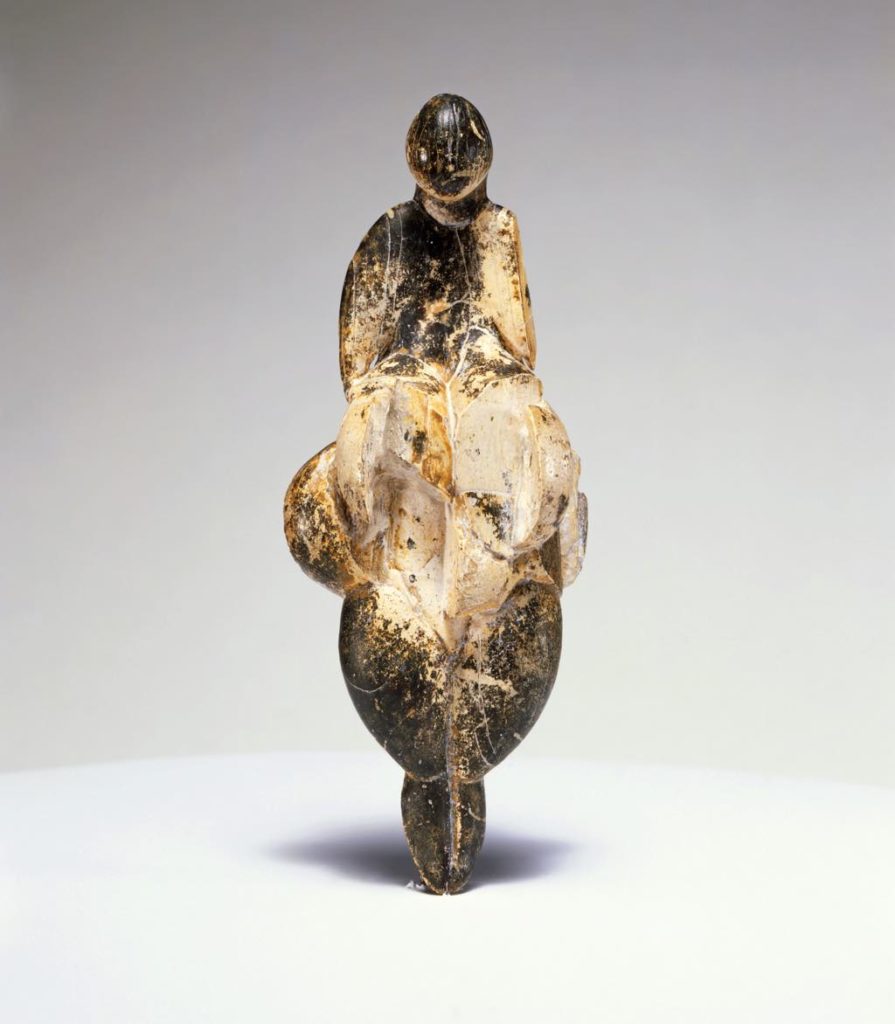
I was as fascinated by the exhibition “Prehistory: A Modern Enigma” at the Centre Pompidou as the artists featured in it were fascinated by prehistoric art.
The premise of the show is that the many new scientific discoveries made during the 19th century concerning human prehistory were enormously inspiring to modern artists. Like Jorge Luis Borges, they might have said, “Around the ghost of myself now orbits the weight of the past. It is infinite.” Naturally, they transmuted that weight into their work.
Speaking for myself, something about prehistoric art – ancient cave paintings, for example – moves me deeply and makes me want to somehow appropriate it, own it, and not just by owning images of it. Since I find that drawing can satisfy this urge to some extent, I can understand why so many artists were and still are inspired by it.
The exhibition beautifully mingles stunning archaeological objects with modern artworks. It starts in a cave-dark room displaying only two objects: a 28,000-year-old Homo sapiens skull found in Les Eyzies-de-Tayac in the Dordogne and an abstract painting by Paul Klee, “Time” (1933), with layers of superimposed gauze painted in earth colors and an arrow pointing to the right in the center, as if looking to the future.
Each artist responded according to his or her own lights. Paul Cézanne and Odilon Redon both had friends who were scientists and became obsessed – especially Redon – with the origins of humans and the earth. Redon is represented here by a number of drawings imagining the life of early humans, as well as series of beautiful and delicate drawings of rock formations. Cézanne was interested in the geological history of the landscape around one of his favorite subjects, Mont Saint Victoire, as seen in a handful of lovely paintings shown here of rocky outcroppings in the area.
Fossils, which proved that many living creatures had gone extinct and raised the same possibility for humans, were another source of inspiration. Alberto Savinio imagined a grotesque departed creature, a kind of fat crocodile, in his “Souvenir d’un Monde Disparu” (1928), while Max Ernst schematized his ideas of stalactites and female bodies above a cross-section of stratified earth in “Paysage Glacières, Stalactites et Minéraux du Corps Féminins” (1920).

In the mid-19th century, the discovery of paleolithic objects like the carved “Venuses,” probably fertility idols, with their huge breasts and buttocks, created another sensation and provided more inspiration for modern artists. In France, the “Venus of Lespugue,” a sculpture some 23,000 years old, fascinated Giacometti and Picasso, both of whom owned replicas of it and both of whom showed a fascination with the archaic in their works (think of Picasso’s prehistoric-looking bathers), a number of which are included in the exhibition. Henry Moore also took inspiration from the Venus figurines.
At the beginning of the 20th century came the greatest artistic discoveries of all: cave paintings. So-called “primitive” humans turned out to be exceedingly sophisticated when it came to painting animals with incredible grace. Giacometti imitated prehistoric man in his own cave, the ground-floor studio he occupied in Paris for 40 years, by painting and drawing on the walls of this “den of mysteries,” as the poet Jacques Dupin called it.
Then there are the great megalithic monuments (which Carl Andre referred to as part of a “great explosion of abstraction”) like Stonehenge and Avebury, which inspired everyone from Romantic painter Caspar David Friedrich to land artist Robert Smithson and sculptor Richard Long.
Toward the end of the exhibition is a surprisingly whimsical installation of colorful prehistoric-looking animals that could easily be marketed as toys (kids will love it) by Jake and Dinos Chapman, who are better known for works with a rather twisted approach to sexuality and mortality.
Which brings up the point that children, like artists, seem to be naturally fascinated by all that is prehistoric – dinosaurs, cavemen, etc. It’s only human.
Favorite
